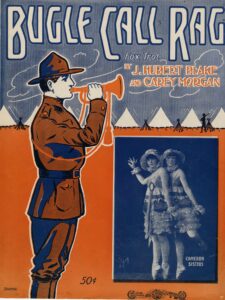YOUR DAILY DOSE OF EUBIE!!!!!!
Eubie met several piano “professors” while working summers in Atlantic City from 190-1915, including Charles “Luckey” Roberts. Born in Philadelphia approximately the same year as Eubie (like Eubie, Roberts gave different stories at different times as to his actual birthdate), Roberts was one of the most accomplished of the East Coast pianists. His first hit came in May 1913 with the publication of “Junk Man Rag.” The piece was advertised as a “one-step,” as a means of promoting it with dancers. Unlike Eubie’s “Charleston Rag,” judging from an early recording by Roberts, Luckey’s piece depends far more on “tricks” in the right hand, such as rapid sweeps up the keyboard, and borrows more heavily from standard figures heard in other early ragtime and jazz compositions. The actual publication was “arranged” by Artie Matthews, the well-known ragtime composer from St. Louis, who favored a politer, more toned down style—like his mentor’s Scott Joplin’s—than the East Coasters performed. Not surprisingly, the published score is much barer than Robert’s own recording to accommodate amateur pianists.
“Junk Man” became a hit when its publisher, Joseph Stern, had lyrics added to it. Eubie noted that he began to hear it performed on Baltimore’s streets by local organ grinders, a sure sign of its popularity. ] Following its success, Roberts arranged for Eubie to have his first two published rags with Stern, “Chevy Chase” (promoted as “a rag”) and “Fizz Water” (labelled by the publisher as a “fox trot”).
Ragtime scholars David A. Jasen and Trebor Tichenor note that “both of these early tunes … are in the mold of the popular one-step and foxtrot dance tunes of the teens.” They incorporate the typical syncopated fox-trot rhythm found in many other dance numbers of the time. Eubie was disappointed when Stern had arranger Stephen O. Jones “simplify” his pieces to make them easier for the amateur pianist to play. (Jones was a Broadway orchestrator of the teens and ‘20s who worked for a number of Tin Pan Alley publishers.) He complained to him, “I don’t tell you people how to write your music…I think I ought to know my own style…” Eubie felt offended that a white arranger would have to “adapt” his music for a different audience. Nonetheless, the piece was published in this simplified arrangement. On his first published compositions, he was credited as “James Hubert Blake (“Eubie”).”

It’s impossible to know how Eubie played these pieces himself as they were “arranged” for publication and he didn’t record either rag at the time. Based on the published scores, “Chevy Chase” is the more interesting of the two works, with a dramatic minor opening theme set against a contrasting major B section and jaunty trio. The piano effects—including dramatic stop time, unaccompanied right hand riffs (in the opening), and Eubie’s characteristic bass–all make this a memorable rag. “Fizz Water” is altogether more conventional, at least as it exists in score, sounding like a typical novelty piece of the era.
Eubie’s contract with Stern was none too generous; he was paid $1.00 out of hand, along with a royalty of one cent per copy sold, for all rights to two piano solos. In the account statements that Eubie saved, in their first year “Chevy Chase” sold 1617 copies, earning him $16.17 in royalties, while the less popular “Fizz Water” managed to sell only 388 copies earning him a meager $3.88. In all likelihood, Stern trashed all copies after the first year’s sales were so poor. (In comparison, Irving Berlin’s 1909 hit “Alexander’s Ragtime Band” reportedly sold half-a-million copies in its first month of sale.) Eubie quickly learned that writing virtuosic piano pieces was not a path to easy riches; even Roberts’s “Junk Man Rag” only became a hit when it was wed with lyrics. His desire to write songs clearly was motivated partially by the fact that they could become major hits through their performance by vaudeville and Broadway stars. A tricky finger-buster was too good to capture the hearts and fingers of amateurs.

Eubie claimed that he also played for Stern another piece that he had adapted from pianist Hughie Woolford—a piece that would later become the major hit “Ragging the Scale.” Woolford had created the tune based on Eubie’s quip that he’d rag anything—including the scale. However, when Eubie played it for Stern, the publisher said, “Great, but who the hell can play it? You can’t sell that,” so passed on it. When “Ragging the Scale” became a major hit for white composer Eddie Claypool later in 1915, Eubie was justifiably irritated that someone else had scored on his idea, so he started to think about another simple theme he could “rag.” The result was a collaboration with popular white composer Carey Morgan on a piece called “Bugle Call Rag,” which Stern published to cash in on Claypool’s hit. Morgan is best-known today for composing pop ditties like “Sippin’ Cider through a Straw.” Although called a “rag” and published as a “fox trot,” the piece is actually a march playing off the well-known short bugle melody used by the army to rouse the troops. Written in 4 parts—like most marches (and rags)—the rhythm is as four-square as can be in the published version, and the melody borrows from other popular songs like “Hot Time in the Old Town Tonight.” Although it far outsold Eubie’s own rags, it didn’t match the success of Claypool’s number. “The novelty had worn off,” Eubie said ruefully.